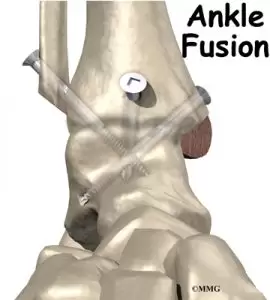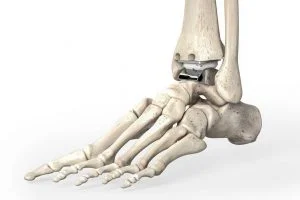A total ankle arthroplasty (or total ankle replacement) is a surgical procedure performed to replace the joint surfaces of the ankle or talocrual joint. Specifically, it will replace the distal end, or far end, of the tibia and proximal end, or top of the talus with prosthetic or artificial parts.
Total ankle arthroplasty procedures have exponentially increased in recent years due to improved outcomes, surgical techniques, and new implant designs. This being said, you may know a friend or family member receiving a total ankle arthroplasty in the near future. But when do you get one?
Who Gets Total Ankle Arthroplasties?
Different surgeons have specific criteria a patient may or may not need to meet for them to perform the surgery.
Examples of criteria used by a surgeon:
- Age
- Weight
- Medical history
- Physical activity level
- Traumatic injury
- Exhaustion of conservative interventions
This being said, like most joint replacements, a total ankle arthroplasty is typically performed as a result of chronic arthritis that has destroyed the articular surfaces of the joint and when conventional conservative methods have failed to decrease pain and/or restore function. This destruction of the articular surfaces result in difficulty and pain with walking, weight bearing, and as you can imagine most activities of daily living.
Benefits of a Total Ankle Arthroplasty
As said before, chronic ankle arthritis can cause significant pain and mobility impairments. The total ankle arthroplasty not only replaces these surfaces, but restores the mobility of this joint with the placement of artificial or prosthetic parts. The restoration of this mobility will help restore the body’s ability to utilize normal biomechanics in the foot and ankle during weight bearing activities. Being able to restore the normal biomechanics decreases the stress on surrounding joints. This decreased stress will decrease the rate of arthritis in these joints that would happen in other surgeries such as ankle fusions, which is mentioned later.
Lifetime of a Total Ankle Arthroplasty
As you may have heard, all joint replacements last a particular time until they have become “worn out”. The lifetime of a total ankle arthroplasty, and most weight bearing joint replacements, tends to depend on age, usage (activity level), weight, mobility or available motion, previous injury, and more. It is said that on average a revision is typically needed after about 10-15 years, but can last up to 20. With surgical procedures and prosthetic implants improving this number could change in the near future.
Procedure
The patient is placed under general anesthesia with a nerve block and positioned on their back. A small incision of about 10 cm (depends on surgeon) will be performed on the front of the ankle through the midline of the joint. After the incision is made the joint area will be “cleaned out”. Then the ends of the tibia and talus will be removed and replaced with prosthetic implants.
Post-Op after a Total Ankle Arthroplasty
It is important to know that no joint replacement surgery is a quick fix and will include pain, swelling, and a period of limited mobility and activity. Post-op protocols during physical therapy differ between surgeons and patients, but all include some sort of physical therapy. After the surgery, a patient may or may not have home health PT then transition to out-patient physical therapy depending on the case. Below is a general list of restrictions and goals for each time period after a total ankle arthroplasty. Actual and specific interventions will be tailored towards the individual to meet the patient’s specific goals.
Week 0-2
- Non-weight bearing on operative leg with a cast
- Focus on walking with an assistive device (crutches or walker)
- Active range of motion of the hip and knee
- Control pain and swelling
Week 2-6
- Walking boot will be implemented and be worn 24/7 except for doing exercises and hygiene
- Progress to walking with the boot with or without an assistive device
- Focus on active range of motion of the ankle
Week 6-10
- Patient will be weaned off the walking boat to walk in a shoe
- Weight bearing exercises, cycling, and swimming (if wound is healed)
- Manual therapy
- Gait (walking) training without boot with/without assistive device
- Hip and knee strengthening
Week 10-14
- Progress hip and knee strengthening exercises
- Continue gait training with/without assistive device
- Introduce ankle strengthening and balance exercises
Week 14+
- Higher level balance activities
- Progress ankle strengthening
- Return to normal activities
Realize it may take up to 12 months after surgery for pain and swelling to completely dissipate and to return to “normal”. Also, physical therapy interventions and timelines may be slightly different between patients due to the specific nature of the surgery, pre-surgery level of function, and goals of the individual.
Ankle fusion vs Total Ankle Arthroplasty

An ankle fusion is another common surgical intervention that is used to treat severe arthritis of the ankle or talocrual joint. Before the improvement of the total ankle arthroplasty it used to be the go-to surgery for severe ankle arthritis. Like a total ankle arthroplasty, it will remove the ends of the talus and tibia, but instead of replacing it with prosthetic parts they will fuse them together. It is said that this surgery is more common for more young and active patients because there will be no risk of “wearing out” like an artificial ankle (total ankle arthroplasty), which will result in a subsequent surgery. However, due to the restriction of the motion of this joint, other joints will have to compensate for this. Thus, increasing the chance or rate or arthritis in other joints, usually the foot.
For more specific questions about total ankle arthroplasties and if they are right for you please consult your orthopedic surgeon, primary care physician, and physical therapist.


